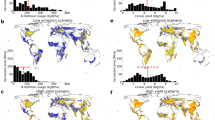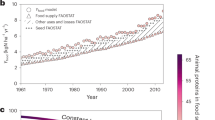Abstract
Organic agriculture is widely accepted as a strategy to reduce the environmental impacts of food production and help achieve global climate and biodiversity targets. However, studies concluding that organic farming could satisfy global food demand have overlooked the key role that nitrogen plays in sustaining crop yields. Using a spatially explicit biophysical optimization model that accounts for crop growth nitrogen requirements, we show that, in the absence of synthetic nitrogen fertilizers, the production gap between organic and conventional agriculture increases as organic agriculture expands globally (with organic producing 36% less food for human consumption than conventional in a fully organic world). Yet, by targeting both food supply (via a redesign of the livestock sector) and demand (by reducing average per capita caloric intake), public policies could support a transition towards organic agriculture in 40–60% of the global agricultural area even under current nitrogen limitations thus helping to achieve important environmental and health benefits.
This is a preview of subscription content, access via your institution
Access options
Access Nature and 54 other Nature Portfolio journals
Get Nature+, our best-value online-access subscription
$29.99 / 30 days
cancel any time
Subscribe to this journal
Receive 12 digital issues and online access to articles
$119.00 per year
only $9.92 per issue
Buy this article
- Purchase on Springer Link
- Instant access to full article PDF
Prices may be subject to local taxes which are calculated during checkout






Similar content being viewed by others
Data availability
Data and material requests should be addressed to corresponding author.
Code availability
The full model code and documentation are freely available via the following GitHub repository: http://github.com/Pie90/GOANIM_public/.
References
Muller, A. et al. Strategies for feeding the world more sustainably with organic agriculture. Nat. Commun. 8, 1290 (2017).
Foley, J. A. et al. Solutions for a cultivated planet. Nature 478, 337–342 (2011).
Mäder, P. et al. Soil fertility and biodiversity in organic farming. Science 296, 1694–1697 (2002).
Bergström, L. & Kirchmann, H. Are the claimed benefits of organic agriculture justified? Nat. Plants 2, 16099 (2016).
Connor, D. J. Organic agriculture and food security: a decade of unreason finally implodes. Field Crops Res. 225, 128–129 (2018).
Connor, D. J. Organic agriculture cannot feed the world. Field Crops Res. 106, 187–190 (2008).
Erb, K. et al. Exploring the biophysical option space for feeding the world without deforestation. Nat. Commun. 7, 11382 (2016).
Nowak, B., Nesme, T., David, C. & Pellerin, S. Disentangling the drivers of fertilising material inflows in organic farming. Nutr. Cycl. Agroecosyst. 96, 79–91 (2013).
Oelofse, M., Jensen, L. S. & Magid, J. The implications of phasing out conventional nutrient supply in organic agriculture: Denmark as a case. Organ. Agric. 3, 41–55 (2013).
Tayleur, C. & Phalan, B. Organic farming and deforestation. Nat. Plants 2, 16098 (2016).
Principles of Organic Agriculture (IFOAM, 2018); https://www.ifoam.bio/en/organic-landmarks/principles-organic-agriculture
European Commission Commission Regulation (EC) No 889/2008. Official Journal of the European Union L 250/1 (2008).
Yussefi-Menzler, M., Willer, H. & Sorensen, N. The World of Organic Agriculture. Statistics and Emerging Trends 2019 (Routledge, 2019); https://doi.org/10.4324/9781849775991
Barbieri, P., Pellerin, S. & Nesme, T. Comparing crop rotations between organic and conventional farming. Sci. Rep. 7, 13761 (2017).
McKenzie, F. C. & Williams, J. Sustainable food production: constraints, challenges and choices by 2050. Food Security https://doi.org/10.1007/s12571-015-0441-1 (2015).
Rigby, D. & Cáceres, D. Organic farming and the sustainability of agricultural systems. Agric. Syst. 68, 21–40 (2001).
Barbieri, P., Pellerin, S., Seufert, V. & Nesme, T. Changes in crop rotations would impact food production in an organically farmed world. Nat. Sustain. 2, 378–385 (2019).
Baudry, J. et al. Improvement of diet sustainability with increased level of organic food in the diet: findings from the BioNutriNet cohort. Am. J. Clin. Nutr. 109, 1173–1188 (2019).
Chaudhary, A., Gustafson, D. & Mathys, A. Multi-indicator sustainability assessment of global food systems. Nat. Commun. 9, 848 (2018).
Smith, L. C. & Haddad, L. Reducing child undernutrition: past drivers and priorities for the post-MDG era. World Dev. 68, 180–204 (2015).
Gibson, R. S. & Hotz, C. Dietary diversification/modification strategies to enhance micronutrient content and bioavailability of diets in developing countries. Br. J. Nutr. 85, S159 (2001).
Mie, A. et al. Human health implications of organic food and organic agriculture: a comprehensive review. Environ. Health 16, 1–22 (2017).
Van Zanten, H. H. E. et al. Defining a land boundary for sustainable livestock consumption. Glob. Change Biol. 24, 4185–4194 (2018).
White, R. R. & Hall, M. B. Nutritional and greenhouse gas impacts of removing animals from US agriculture. Proc. Natl Acad. Sci. USA https://doi.org/10.1073/pnas.1707322114 (2017).
Soussana, J. F. & Lemaire, G. Coupling carbon and nitrogen cycles for environmentally sustainable intensification of grasslands and crop-livestock systems. Agr. Ecosyst. Environ. 190, 9–17 (2014).
Schader, C. et al. Impacts of feeding less food-competing feedstuffs to livestock on global food system sustainability. J. R. Soc. Interface 12, 20150891 (2015).
Persson, U. M., Johansson, D. J. A., Cederberg, C., Hedenus, F. & Bryngelsson, D. Climate metrics and the carbon footprint of livestock products: where’s the beef? Environ. Res. Lett. 10, 034005 (2015).
Mehrabi, Z., Ellis, E. C. & Ramankutty, N. The challenge of feeding the world while conserving half the planet. Nat. Sustain. 1, 409–412 (2018).
Eyhorn, F. et al. Sustainability in global agriculture driven by organic farming. Nat. Sustain. 2, 253–255 (2019).
Badgley, M. C. et al. Organic agriculture and the global food supply. Renew. Agr. Food Syst. 22, 86–108 (2007).
Karlsson, J. O. & Röös, E. Resource-efficient use of land and animals—environmental impacts of food systems based on organic cropping and avoided food-feed competition. Land Use Policy 85, 63–72 (2019).
Watson, C. A. et al. A review of farm-scale nutrient budgets for organic farms as a tool for management of soil fertility. Soil Use Manage. 18, 264–273 (2002).
Nowak, B., Nesme, T., David, C. & Pellerin, S. To what extent does organic farming rely on nutrient inflows from conventional farming? Environ. Res. Lett. 8, 044045 (2013).
Feuerbacher, A., Luckmann, J., Boysen, O., Zikeli, S. & Grethe, H. Is Bhutan destined for 100% organic? Assessing the economy-wide effects of a large-scale conversion policy. PLoS ONE 13, e0199025 (2018).
Ponisio, L. C. et al. Diversification practices reduce organic to conventional yield gap. Proc. R. Soc. B https://doi.org/10.1098/rspb.2014.1396 (2015).
Trimmer, J. T. & Guest, J. S. Recirculation of human-derived nutrients from cities to agriculture across six continents. Nat. Sustain. 1, 427–435 (2018).
Hoornweg, D. & Bhada-Tata, P. What a Waste. A Global Review of Solid Waste Management (World Bank, 2012).
Reganold, J. P. & Wachter, J. M. Organic agriculture in the twenty-first century. Nat. Plants 2, 15221 (2016).
Tuomisto, H. L., Hodge, I. D., Riordan, P. & Macdonald, D. W. Does organic farming reduce environmental impacts? A meta-analysis of European research. J. Environ. Manage. 112, 309–320 (2012).
Crowder, D. W. & Reganold, J. P. Financial competitiveness of organic agriculture on a global scale. Proc. Natl Acad. Sci. USA 112, 7611–7616 (2015).
Bartelt, K. D. & Bland, W. L. Theoretical analysis of manure transport distance as a function of herd size and landscape fragmentation. J. Soil Water Conserv. 62, 345–352 (2007).
De Klein, C. et al. in IPCC Guidelines for National Greenhouse Gas Inventories (eds Buendia, L. & Eggleston, S.) Ch. 11 (IPCC, 2006).
Godard, C., Roger-Estrade, J., Jayet, P. A., Brisson, N. & Le Bas, C. Use of available information at a European level to construct crop nitrogen response curves for the regions of the EU. Agric. Syst. 97, 68–82 (2008).
Sheldrick, W., Syers, J. K. & Lingard, J. Contribution of livestock excreta to nutrient balances. Nutr. Cycling Agroecosyst. 66, 119–131 (2003).
Dong, H. et al. in IPCC Guidelines for National Greenhouse Gas Inventories (eds Buendia, L. & Eggleston, S.) Ch. 10 (IPCC, 2006).
Hogh-Jensen, H., Loges, R., Jorgensen, F. V., Vinther, F. P. & Jensen, E. S. An empirical model for quantification of symbiotic nitrogen fixation in grass-clover mixtures. Agric. Syst. 82, 181–194 (2004).
Liu, J. et al. A high-resolution assessment on global nitrogen flows in cropland. Proc. Natl Acad. Sci. USA 107, 8035–8040 (2010).
Dentener, F. et al. Nitrogen and sulfur deposition on regional and global scales: a multimodel evaluation. Glob. Biogeochem. Cycles 20, GB4003 (2006).
Monfreda, C., Ramankutty, N. & Foley, J. A. Farming the planet: 2. Geographic distribution of crop areas, yields, physiological types, and net primary production in the year 2000. Glob. Biogeochem. Cycles 22, GB1022 (2008).
Licker, R. et al. Mind the gap: How do climate and agricultural management explain the ‘yield gap’ of croplands around the world? Glob. Ecol. Biogeogr. 19, 769–782 (2010).
Srednicka-Tober, D. et al. Composition differences between organic and conventional meat: a systematic literature review and meta-analysis. Br. J. Nutr. 115, 994–1011 (2016).
Herrero, M. et al. Biomass use, production, feed efficiencies, and greenhouse gas emissions from global livestock systems. Proc. Natl Acad. Sci. USA 110, 20888–20893 (2013).
Van Drecht, G., Bouwman, A. F., Harrison, J. & Knoop, J. M. Global nitrogen and phosphate in urban wastewater for the period 1970 to 2050. Glob. Biogeochem. Cycles 23, 1–19 (2009).
World Population Prospects 2015—Data Booklet (United Nations, 2015); https://doi.org/ST/ESA/SER.A/377
Ahmed, S. & Blumberg, J. Dietary guidelines for Americans, 2010. Nutr. Rev. https://doi.org/10.1016/S0300-7073(05)71075-6 (2009).
Gerten, D. et al. Feeding ten billion people is possible within four terrestrial planetary boundaries. Nat. Sustain 3, 200–208 (2020).
Fetzel, T. et al. Quantification of uncertainties in global grazing systems assessment. Glob. Biogeochem. Cycles 31, 1089–1102 (2017).
Acknowledgements
We are grateful to M. Kvakic and B. Ringeval for their suggestions and help in the model construction. This work was funded by Bordeaux Sciences Agro (University of Bordeaux) and the INRA-CIRAD GloFoodS metaprogramme.
Author information
Authors and Affiliations
Contributions
P.B., S.P. and T.N. designed the study; P.B. collected the data, coded the model and performed the calculations; P.B., V.S., T.N., L.S. and N.R. were involved in the model set-up and improvement. All authors were involved in the interpretation of results and contributed to writing and revising the manuscript.
Corresponding author
Ethics declarations
Competing interests
The authors declare no competing interests.
Additional information
Peer review information Nature Food thanks Elizabeth Stockdale and the other, anonymous, reviewer(s) for their contribution to the peer review of this work.
Publisher’s note Springer Nature remains neutral with regard to jurisdictional claims in published maps and institutional affiliations.
Supplementary information
Supplementary Information
Supplementary Figs. 1–9, Tables 1–5 and References.
Rights and permissions
About this article
Cite this article
Barbieri, P., Pellerin, S., Seufert, V. et al. Global option space for organic agriculture is delimited by nitrogen availability. Nat Food 2, 363–372 (2021). https://doi.org/10.1038/s43016-021-00276-y
Received:
Accepted:
Published:
Issue Date:
DOI: https://doi.org/10.1038/s43016-021-00276-y
This article is cited by
-
Beyond circularity! Integration of circularity, efficiency, and sufficiency for nutrient management in agri-food systems
Nutrient Cycling in Agroecosystems (2024)
-
Elucidating the effects of organic vs. conventional cropping practice and rhizobia inoculation on rhizosphere microbial diversity and yield of peanut
Environmental Microbiome (2023)
-
Sevenfold variation in global feeding capacity depends on diets, land use and nitrogen management
Nature Food (2023)
-
Soil organic carbon stocks potentially at risk of decline with organic farming expansion
Nature Climate Change (2023)
-
Agricultural input shocks affect crop yields more in the high-yielding areas of the world
Nature Food (2023)



